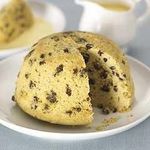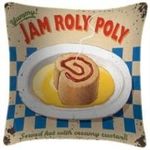A SHORT HISTORY, YORKSHIRE and PUDDING
←
→
Page content transcription
If your browser does not render page correctly, please read the page content below
YORKSHIRE and PUDDING;
A SHORT HISTORY,
Some background information
& A few recipes
A few millennia in a few lines:
While woolly rhinoceroses and mammoths are no longer
likely to be spotted roaming the moors, there are still
barrows, monoliths, and henges to be seen in Thornborough
dating from the Neolithic era (does the word „henge‟ ring a
bell? Yes, Stonehenge is another)
The Romans had their hey-day as well, leaving behind the
still famous Hadrian‟s Wall (2nd century) that runs from
the River Tyne to the shore of the Solway Firth.
Even the Danes (helped by the Norwegians) found
Yorkshire quite to their taste, colonizing the place for well
nigh 200 years, until the Normans booted them out in
1066. After the Tudor period, there were far fewer
uprisings, and Yorkshire prospered during the Industrial
Revolution of the 19th century. However, the coal, steel,
wool and shipping industries were hard hit in the decline of
manufacture and Yorkshire fell upon hard times.
Yorkshire‟s claim to fame is not limited to the small, yapping, oft-beribboned dog; it can boast of
being home to some Very Famous People from a wide variety of walks in life. Here is a smattering of
VFP whose origins are Yorkshire:
David Hockney (artist)
James Mason, Ben Kingsley (actors)
William Wilberforce (campaigned against slavery)
Herbert Asquith (PM of Great Britain, early 20th century)
Thomas Chippendale (not in the show, the furniture maker...)
W.H. Auden (poet, writer)
thebBut surely, for the food lover lurking beneath the surface of the French national‟s seeming disdain
for any non-French cuisine, (disdain more particularly directed at English Cooking), surely even he
cannot ignore Pudding ! Here then is a far too brief bit about that national dish.
Pudding : Pronunciation : /p ʊ d i ŋ /
Accepted short form : pud
Definition : dessert (GB)
an egg-based, creamy dessert
a boiled or steamed cake
a savory, served with roast beef
An overview through the Ages :
In ancient times: the first puddings were probably similar to a sausage, encased in something natural
that served as a bag; boiled.
Medieval Era: black or white, mostly meat-based.
17th century : Either savory (with meat) or sweet (flour, nuts, sugar); cooked in bags especially
designed for the purpose. Pease Porridge was a simple boiled pudding made of... pease meal!
18th century : Meat was eased out of the traditional puddings which became sweeter. Suet was
however used as a substitute for butter (this fatty agent that surrounds beef or veal kidneys is still
a required ingredient for traditional Christmas mincemeat and pudding today)
19th century : puddings were still boiled but due to changes in recipes, resembled cakes (Christmas
pudding, or today‟s steamed dessert puddings)
Dessert: “What‟s for pud mum?”
Great Britain: pudding is a generic term, often simply meaning “dessert”, “afters”, “a
sweet”.
America: a custardy dish, which definitely has its origins in the Middle Ages. It was either
eaten alone, or used as a filling for pies, tarts, pastry, etc. The split between the boiled
pudding known in Britain, and the egg-based custard is thought to have originated in the
1840s in America. At this time in the New World, food was plentiful so the somewhat
stodgy, boiled puddings were no longer needed to feed households.
This moment of plenty also coincided with an English chemist‟s invention of the
„custard powder‟ as an alternative to the traditional egg thickener. The mid 1800s
also saw the conquest of the Wild West and Custard Powder quickly crossed the
Atlantic to the New World, where it was seen as a Godsend by the „overland‟ wagon
cooks to whom fresh eggs were neither freely available, nor easy to keep! (Even
today, Alfred Bird is a name known to all English housewives, as it adorns many a tin
of Custard Powder).Yorkshire pudding. A puffy, bread-like side dish made by cooking an egg and milk batter in the hot fat and pan drippings from a roast beef. It is a traditional English dish named after a northern county in England. No one seems to know where Yorkshire pudding came from. There are no cave drawings, no hieroglyphs, not even a shadow of an ancient Yorkshire „pud‟ unearthed in some Roman kitchen...however, in 1737 a marvelous book entitled The Whole Duty of a Woman refers to a Dripping Pudding – the dripping obviously coming from something that had been roasted on a spit, over a fire. 'Make a good batter as for pancakes; put in a hot toss-pan over the fire with a bit of butter to fry the bottom a little then put the pan and butter under a shoulder of mutton, instead of a dripping pan, keeping frequently shaking it by the handle and it will be light and savory, and fit to take up when your mutton is enough; then turn it in a dish and serve it hot.' In those times, meat was less commonly consumed due to the high cost, and if there was not enough to go round, the children had to be satisfied with just the pudding, albeit flavored with meat juices and dripping. Today it is often eaten filled with lovely onion gravy, so that the pudding is actually an edible serving dish! This, it has been suggested, might stem from the days when very poor people couldn‟t afford crockery. Another version of Yorkshire pudding is served with a sausage cooked in the middle, and has an altogether enticing name: TOAD-IN-THE-HOLE!! Pudding cloths, invented in the 17th century, allowed for the cooking of puddings in ovens that were becoming more and more common in ordinary houses – not as terribly hot a bread ovens, they were added on to the chimney breast, or built as an appendage of the bread oven. Boiled puddings became popular in the 18th century – plain but also sweetened sponge puddings, to be followed by meat based puddings – steak and kidney, for example! But it was not until the beginning of the 20th century that boiled, or steamed puddings came into vogue – cooked in a pudding basin, covered either with a pudding cloth or, more recently foil or greaseproof paper, there are all sorts of examples, jam roly-poly, spotted dick, treacle pudding to name but a few. Recipes below!
Method:
Yorskshire Pudding Preheat the oven to 225°C – it must be HOT!
4 oz/ 100 g flour Put the flour, salt and pepper in a bowl and mix well.
½ tsp salt Beat the eggs and milk until well mixed.
Pinch of pepper Slowly add the liquid to the flour mixture, beating with a whisk all the
1 tbsp suet (for the pan – time so as to avoid lumpy batter.
you can also use butter) Put some suet or butter into a large tin or individual patty tins, and
2 eggs place them in the oven for 5-10 minutes, or till the fat is really hot.
200ml milk + 50 ml water Carefully pour the batter into the tins and let the puddings cook for
Total liquid = ½ pint 15 minutes (individual patties) or 30 minutes (one larger pudding).
They should rise well around the edges and be a golden brown colour.
Serve with roast beef, peas, beans, and lots of gravy!
Spotted Dick
115g / 4oz raisins
55g / 2oz currants
75g /3oz brown sugar
Grated zest of 1 lemon
225g / 8oz flour
1 heaping tsp baking powder
115g /4oz shredded suet (or butter)
Pinch of salt
55ml /2 fl oz milk
Method :
1. In a small bowl mix the raisins, currants, sugar and lemon rind for the filling.
2. Sift the flour into a large mixing bowl; add the suet and the salt and rub together to combine. Add
a little milk and using a knife cut through the mixture, adding more milk little by little until it
comes together. Finally use your hands to combine into a soft, elastic dough. Add more milk if
necessary.
3. Place the dough on a lightly floured surface and roll into a rectangle approx 20cm x 30cm (8 x 12
inches).
4. Evenly spread the pudding filling mixture over the dough leaving a 1cm/ 1/2 inch border. Paint the
border with a little cold water. Roll up carefully from the narrow end.
5. Soak a clean tea towel or cloth napkin in boiling water for a few minutes, squeeze to remove excess
water.
6. Wrap the suet roll pudding in the napkin twisting at each end at securing with kitchen string
7. Steam the pudding roll for 2 hours in a steamer. Alternatively, wrap the pudding suet roll in foil
and bake in a hot oven (200ºC/400ºF/Gas 6) for 1 hour 30 mins. Unwrap immediately, cut into thick
slices and serve in warmed bowls with lashings of custard.
Probably shouldn‟t be eaten on a hot summer‟s day but great on a cold, grey, wet, chilly Sunday!Golden Syrup Pudding
100g/3½oz unsalted butter, softened,
2 tbsp golden syrup, plus extra for serving
115g/4¼oz plain flour, sifted
1½tsp baking powder
2 large free-range eggs
115g/4¼oz brown sugar
vanilla custard, to serve (optional)
1. Generously grease a 900ml/1½ pints pudding basin with butter, then chill in the fridge for 4-5
minutes.
2. When the basin is chilled, drizzle the golden syrup into the base of the basin.
3. In a large mixing bowl, whisk together the flour, baking powder, eggs, brown sugar and butter until
the batter is smooth and well combined. Spoon the cake batter into the pudding basin.
4. Fold a large piece of aluminum foil in half and grease one side with butter. Wrap the pudding in the
greased foil, greased side facing into the pudding. (Pleat the foil a few times as you wrap it to allow
room for the pudding to expand.) Secure the foil to the rim of the pudding basin with string.
5. Place the wrapped pudding into a large steamer. (Alternatively, place the wrapped pudding into a
large pan, pour in enough boiling water to reach halfway up the sides of the basin then cover the
pan with a lid.) Steam the pudding over a medium heat for 1 hour 30 minutes, or until cooked
through, topping up the steamer with boiling water as necessary. (NB. The pudding is cooked
through when a skewer inserted into the centre comes out clean.)
6. To serve, turn the steamed pudding out into the centre of a serving plate. Cut it into slices and
drizzle over any remaining golden syrup, to taste. Serve with extra golden syrup and vanilla custard,
if desired.
Note: in days or yore, treacle was often used as golden syrup – far lighter – was not yet around!
The latter can be found in many gourmet shops in France.
TOAD IN THE HOLE
1. Preheat the oven to 200 degrees C /gas mark 6.
2. Pour the oil into the bottom of a baking dish, and arrange the
8 pork sausages
sausages over it in a single layer. Bake for 10 minutes in the
1 tablespoon vegetable oil
preheated oven.
225g (8 oz) plain flour
4 eggs 3. Meanwhile, in a medium bowl, whisk together the flour, eggs
250ml (8 fl oz) milk and half of the milk until smooth. Gradually mix in the rest of
salt and pepper to taste the milk until a smooth batter is achieved. Season with salt and
pepper.
4. Remove the sausages from the oven, and ladle the batter over
them until the sausages are 3/4 covered. Return to the oven,
and bake for 35 minutes, or until the centre is risen and
browned. Don't worry if the underside seems slightly soft, as
this is normal.
Note: lots of famous, modern cooks have made this simple, basic dish far more sophisticated
with additions such as bacon, pancetta, rosemary, and whatnot. You can find them all online.You can also read



























































